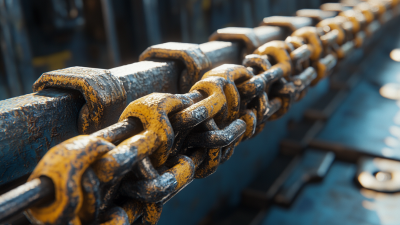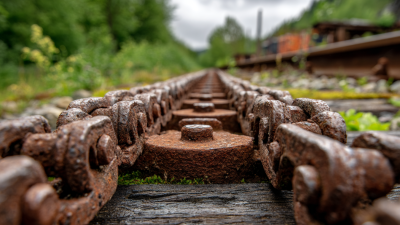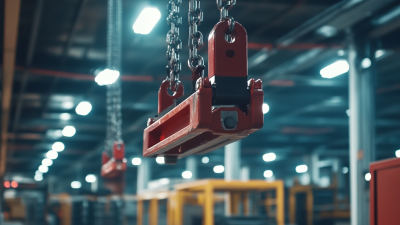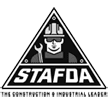
How to Safely Operate a Chain Fall for Maximum Efficiency and Safety
The safe operation of a Chain Fall is essential in various industries, particularly in construction and manufacturing, where heavy lifting is a routine necessity. According to a report by the Occupational Safety and Health Administration (OSHA), improper use of lifting equipment accounts for a significant percentage of workplace injuries, making it critical for operators to be well-versed in best practices. Efficiently utilizing a Chain Fall not only enhances productivity but also minimizes risks associated with heavy lifting. The National Institute for Occupational Safety and Health (NIOSH) estimates that implementing proper training and operational protocols can reduce lifting-related injuries by up to 50%. This article aims to provide a comprehensive guide on the safe and efficient operation of Chain Falls, ensuring both optimal performance and worker safety. By adhering to these guidelines, operators can significantly contribute to a safer work environment and promote overall efficiency in their operations.

Understanding the Basics of Chain Fall Operation and Mechanism
Operating a chain fall, a type of manual hoist, requires a solid understanding of its mechanics and operational principles to ensure both efficiency and safety. At its core, a chain fall utilizes a system of pulleys and a chain to lift and lower heavy loads. The mechanical advantage provided by this setup allows the operator to handle significantly heavier weights than they could manage manually. Familiarity with the components, such as the hook, chain, and ratchet mechanism, is essential for effective use.
Before engaging in operation, it is critical to inspect the chain fall for any signs of wear or damage. Proper maintenance ensures that the mechanisms function smoothly and safely. Operators should maintain a safe distance from suspended loads, never exceeding the specified weight limit to avoid potential accidents. It is also important to maintain two hands on the chain fall while in operation, keeping body parts clear of moving parts. By understanding these fundamental aspects and following safety protocols, operators can effectively utilize a chain fall while minimizing risks.

Essential Safety Gear and Equipment for Chain Fall Use
When operating a chain fall, safety gear and equipment play a crucial role in maximizing efficiency and minimizing risks. Personal protective equipment (PPE) is essential for workers involved in lifting operations. Hard hats protect against falling loads, gloves improve grip and dexterity, and steel-toed boots provide foot protection against heavy equipment. Moreover, safety goggles can shield eyes from debris, ensuring complete coverage during the operation.
In light of recent supply chain disruptions affecting PPE availability, it is vital for operators to prioritize safety measures. Shortages of essential gear can significantly increase the risks of injuries, as seen in unfortunate incidents where equipment failures have led to severe accidents. Consequently, ensuring access to the right safety gear not only protects workers but also enhances overall operational efficiency. The commitment to employing quality safety equipment is indispensable, particularly in high-demand scenarios where the risk of accidents can rise sharply.
Chain Fall Operation Safety and Efficiency
Step-by-Step Guide to Setting Up a Chain Fall Correctly
When setting up a chain fall, safety and efficiency are paramount. Start by selecting a sturdy overhead support that can bear the load you'll be lifting. Ensure that the area is clear of obstacles and potential hazards. The first step is to properly attach the hook or lifting mechanism of the chain fall to the load, making sure it is secure and stable. Double-check the weight capacity of your chain fall to avoid overloading it, which can lead to dangerous malfunctions.
Tips: Always wear appropriate personal protective equipment (PPE) such as gloves and safety goggles when working with heavy machinery. This ensures personal safety and minimizes the risk of injuries.
Next, test the chain fall’s functionality before beginning your project. Gently raise the load a few inches off the ground to confirm that everything is working smoothly. As you lift, maintain a steady and controlled operation. Avoid sudden jerks or movements that can destabilize the load. If you feel any resistance or notice any irregular sounds, stop immediately to assess the situation.
Tips: Keep your hands and body clear of the lifting path and never attempt to catch a slipping load with your body. Always have a plan in place for emergencies to enhance safety while operating the chain fall.
Best Practices for Load Handling to Ensure Safety and Efficiency
When handling loads with a chain fall, adhering to best practices is imperative to ensure both safety and efficiency. According to the Occupational Safety and Health Administration (OSHA), improper lifting can lead to severe injuries, with back-related incidents accounting for over 20% of workplace injuries. To mitigate these risks, operators should always inspect the chain fall before use, ensuring that all components are in good working condition and that the load capacity is not exceeded.
Tips: Always wear appropriate personal protective equipment (PPE), including gloves and a helmet, to safeguard against potential hazards. When lifting loads, maintain a clear area around the lifting zone and communicate effectively with coworkers to prevent accidents.
Moreover, optimizing load handling involves understanding the center of gravity and ensuring proper balancing. A study by the National Institute for Occupational Safety and Health (NIOSH) emphasizes that unbalanced loads can lead to tipping hazards and increased strain on operators. Leveraging mechanical advantage by using the correct rigging methods will enhance efficiency, reduce energy expenditure, and lower the risk of accidents associated with mishandled weights.
Tips: Taglines can be utilized to help guide the load during lifting and to keep hands away from pinch points. Always have an emergency plan in place to respond to potential incidents swiftly.
Regular Maintenance Tips to Extend the Life of Your Chain Fall
Regular maintenance is crucial for extending the lifespan of your chain fall and ensuring optimal performance. According to a report by the Occupational Safety and Health Administration (OSHA), improper maintenance of lifting equipment can lead to workplace accidents, which account for approximately 20% of all reported injuries in the construction sector. To mitigate these risks, operators should implement a routine inspection schedule that includes checking the chain for wear and tear, ensuring that the hooks are not damaged, and examining the operating mechanism for any signs of corrosion or malfunction.

In addition to inspections, lubricating the chain and moving parts is essential. A study by the American Society of Mechanical Engineers (ASME) indicates that regular lubrication can reduce friction and wear, potentially extending equipment life by up to 30%. Operators should be trained in recognizing the signs of overloading, which typically include chain deformation and unusual noise during operation. By adhering to these maintenance tips, workers not only enhance safety but also maximize the efficiency and longevity of their chain falls, ultimately contributing to a safer work environment.
Related Posts
-

The Definitive Ultimate Guide to Choosing the Best Chain Fall Hoist for Your Needs
-

How to Select the Right Chain Come Along for Your Heavy Lifting Needs
-

Elevating Global Standards: The Rise of Premium Chain Come Along from China
-

Enhancing After Sales Support and Repair Costs for the Future of Best Chain Falls
-

The Ultimate Guide to Choosing the Right Chain Come Along for Your Needs
-

How to Maximize Safety and Efficiency with Lever Hoist in Industrial Applications
Copyright ©2024 Elephant Lifting Products | All rights reserved.
38381 N Robert Wilson Rd, Gonzales, LA 70737 USA
Toll Free: (888) 844-6113 | Phone: (225) 644-6113 | Fax: (225) 644-6695
Email: sale@floralift.org




